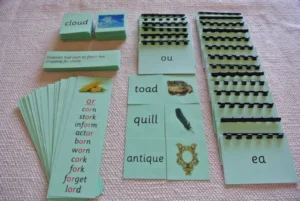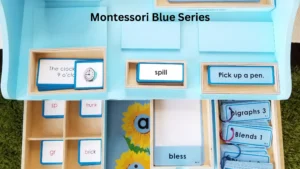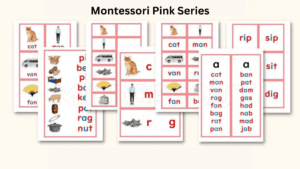Montessori Trinomial cube is another sensorial material in Montessori education that could help a child learn allergic expressions without much hassle. It is introduced to the child after they get familiar with the Montessori Binomial Cube.
What is a Montessori Trinomial Cube?
A Trinomial cube consists of 27 wooden blocks in varying colours and sizes that fit together to form a cube. These wooden blocks include 3 cubes of colour red, yellow, and blue. It also has 18 rectangular prisms – 6 black and red, 6 black and blue, 6 black and yellow prisms. Apart from these, it also contains 6 black prisms all of which vary in size. These contents come in a wooden hinged box.
Each block represents a mathematical expression of the Trinomial theorem (a + b + c) ³. It offers the children to explore and discover the relationships between different dimensions and quantities in hands-on manner. It is similar to the Montessori Trinomial cube where the child assembles the cube by putting together blocks to form the cube printed on the lid.
The children build their skill and depth perception while correctly building the cube inside the box. Through the manipulation of the blocks, children engage in a sensorial experience. This fosters problem-solving, logical thinking, and a deeper grasp of abstract mathematical concepts.
Benefits of Montessori Trinomial Cube
The goal of the material in the early stages is to challenge a child’s ability to identify patterns and relationships between the blocks rather than to focus on the intricate mathematics behind the material.
The Montessori Trinomial Cube offers a range of benefits for children as they engage with this educational tool.
- The cube aids in the child’s understanding of spatial relationships.
- The child would be able to distinguish between colours, patterns, and shapes visually.
- This cube helps the children comprehend mathematical concepts in a tangible way making complex ideas simpler.
- Assembling the cubes promotes the problem solving skills, logical thinking, and spatial reasoning in the child.
- Handling the box, the cubes, and the prisms enhances the fine motor skills along with hand-eye coordination.
- As children solve the puzzle and successfully complete the cube, it boosts their confidence, resilience, and willingness to tackle challenges.
Presentation of the Montessori Trinomial Cube
It is best to let the child perceive the Trinomial cube as a three-dimensional puzzle so that they can concentrate on the pattern and spatial relationships rather than the mathematical formula.
- Invite the children to the table in small groups.
- Take off the box’s lid to reveal the finished cube’s painted surface facing upward.
- Carefully remove each block from the box one at a time by pulling down one side at a time.
- Arrange the blocks according to colour. To ensure that the colour is seen clearly, make sure to leave an inch of space.
- Begin forming the top layer of the cube with the yellow cube.
- Next, add more blocks in a left-to-right and top-to-bottom pattern.
- Place the finished trinomial cube in the upper part of the table.
- For the trinomial cube’s middle and bottom layers, follow the same process.
- Make a column by starting with the red cube from the bottom layer and removing each block from the preceding blocks according to its orientation.
- Start moving the box inside the main box in the same pattern after the correct column has formed.
- Following the design on the lid, repeat the pattern with the remaining two layers.
- Allow the children to assist if they have recognized the pattern.
- Once the second layer is finished, demonstrate to the child that it is flat once more with a hand.
- Close the box, side by side and place the lid at the end.
Exercises for the Montessori Trinomial Cube
Here are some ideas that educators can use to help the children understand the concept of this cube.
Exercise 1 – As stated in the section of Presentation, allow the child to work individually on the Montessori Trinomial cube. Assist if needed.
Exercise 2 – Set up the box as stated in the presentation and invite the child. To the right of the box, remove all of the cubes and prisms and group them together.
After that, close the box and set it aside. As in the presentation, assemble the Trinomial cube, but this time without using the box. After finishing, mix the prisms and instruct the child to construct it, outside the box.
Exercise 3 – Build the Trinomial cube again, following the steps in Exercise 2. After it is constructed outside of the box, cut the cube in half vertically. Turn them to show the child that they are the same. After the cube has been reformed by joining the halves, carefully remove the top layer and place it next to the bottom layer to demonstrate how similar they both appear. Have the child separate the layers after replacing them.
Final Words
The Montessori trinomial cube is an educational tool, symbolising Maria Montessori’s philosophy of hands-on, sensorial learning. The cube effectively aims to improve fine motor skills in children. Fostering a child’s understanding of spatial relationships, volume, and algebraic concepts in a tangible, concrete manner is the indirect goal of the cube.
The intricate design of the cube encourages problem-solving, coordination, and cognitive development. It also promotes independence and a sense of accomplishment as children assemble its colourful components. An excellent method to introduce a child to algebraic operations is through the use of Montessori Binomial and Trinomial Cubes.




